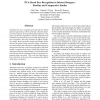Free Online Productivity Tools
i2Speak
i2Symbol
i2OCR
iTex2Img
iWeb2Print
iWeb2Shot
i2Type
iPdf2Split
iPdf2Merge
i2Bopomofo
i2Arabic
i2Style
i2Image
i2PDF
iLatex2Rtf
Sci2ools
AMFG
2003
IEEE
2003
IEEE
PCA-Based Face Recognition in Infrared Imagery: Baseline and Comparative Studies
Techniques for face recognition generally fall into global and local approaches, with the principal component analysis (PCA) being the most prominent global approach. This paper uses the PCA algorithm to study the comparison and combination of infrared and typical visible-light images for face recognition. This study examines the effects of lighting change, facial expression change and passage of time between the gallery image and probe image. Experimental results indicate that when there is substantial passage of time (greater than one week) between the gallery and probe images, recognition from typical visible-light images may outperform that from infrared images. Experimental results also indicate that the combination of the two generally outperforms either one alone. This is the only study that we know of to focus on the issue of how passage of time affects infrared face recognition.
| Added | 04 Jul 2010 |
| Updated | 04 Jul 2010 |
| Type | Conference |
| Year | 2003 |
| Where | AMFG |
| Authors | Xin Chen, Patrick J. Flynn, Kevin W. Bowyer |
Comments (0)

